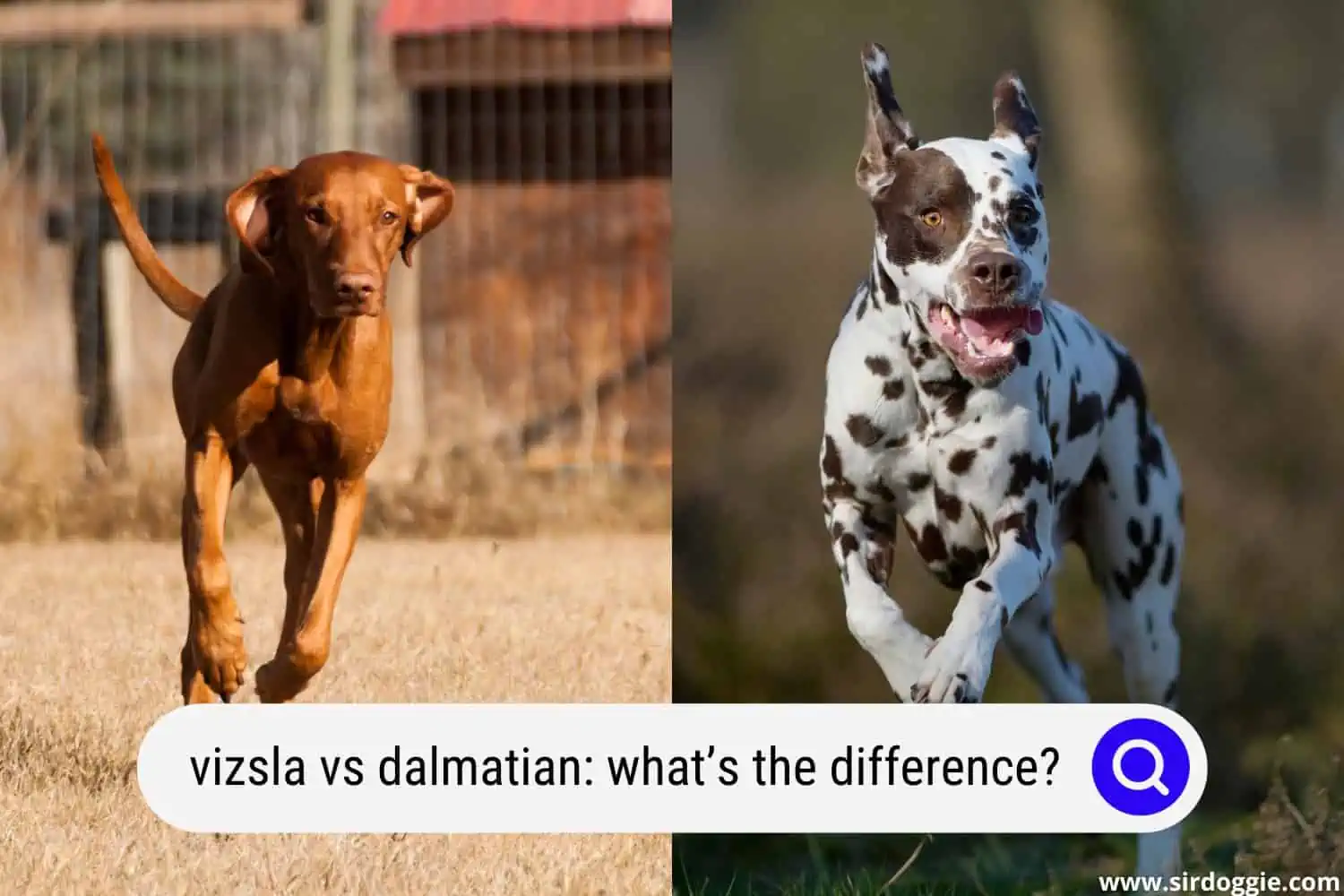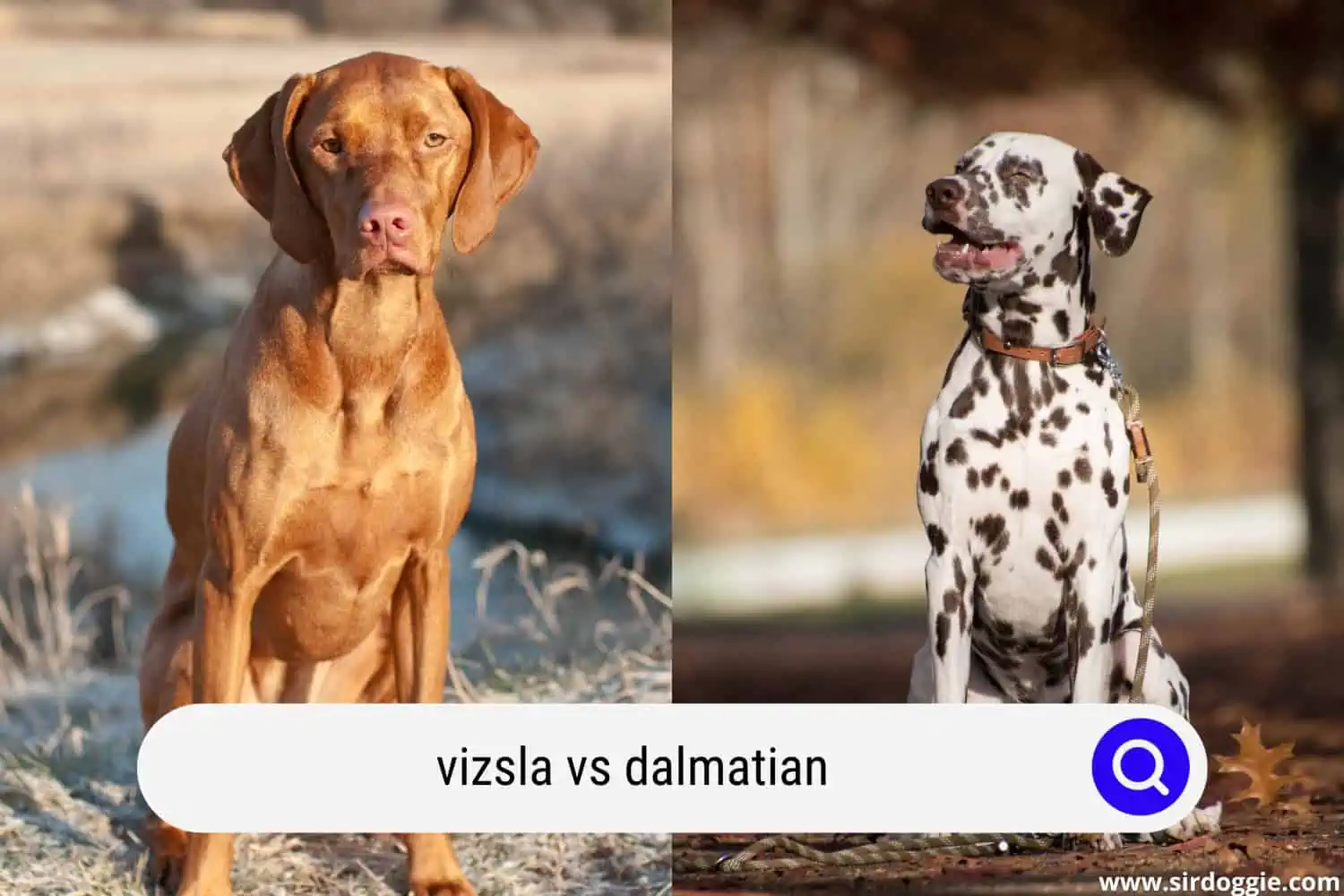Vizsla vs Dalmatian: What’s the Difference?
The Vizsla and Dalmatian aren’t the good-looking dog species you would love to keep as a pet. They don’t have cute eyes or beautiful fur like the likes of ragdolls. However, both species are affectionate, athletic, and gentle-mannered.

If you’re in the market for an athletic breed that can double up as a companion, these two breeds will be high on your list. In this guide, we outline the unique features of both dog species and the purpose they can serve in your home.
About the Vizsla
The Vizsla also known as the Hungarian pointer, is a type of hunting dog used by the Magyars, a tribe in Hungary. This dog species was used by warlords and hunters to hunt down birds and small games.
However, Vizslas have revolutionized from hunting companions. Their affectionate nature means they’re kept as human companions nowadays. They resemble the kind of dog you keep indoors to wade off uninvited guests.
They prefer to move around the house, the reason their keeper needs to draft a daily workout routine for them. A Vizsla hardly barks if given the attention they need. Only a bored Vizsla barks loudly or exhibits hyperactivity behaviors such as chewing for long hours.
Overall, they do adapt to their environment easily and love to cuddle. This makes them a perfect fit for households with young kids.
Vizsla Physical features
A Vsizla is well–built with long legs. The male breed is 22 – 24 inches tall while a fully matured female Vizsla can only attain 23 inches at most. It takes a year or two for them to reach maturity and they begin to wither in as little as 8 months.
The coat of a Vsizla isn’t pretty like that of a Siberian husky but they’re not ugly either. The coats are short and very close to the skin. There are no thick undercoats and they rarely shed their short, smooth fur. Their skin is easy to maintain. A rubdown is enough but it won’t hurt to brush down with a rubber brush. Most breeds spot golden rust coats.
Vizsla Behavior
A Vizsla is gentle, lively, and affectionate. They have an athletic build, hence, they require a lot of movement around their space. The reason they’re mostly kept in homes with a high fence is so they can play around.
As much as they’re adventurous, Vizslas favors human companionship. They love to be touched and would jump on their keeper out of excitement. Without anyone to play with, they might develop separation anxiety. This is why they are not recommended for individuals who stay out of the house for long hours.
Also, exercise and socialization are a must for Vizslas. They can be difficult to control if they’re not properly trained. The reason they should stay indoors with their keeper and not outdoors in the cold where they’re bound to get lonely.
Vizsla Health
Vizslas rarely suffer from life-threatening health conditions. However, it’s important to be aware of the symptoms of the following diseases – Epilepsy, Canine Hip Dysplasia, and Hypothyroidism. The issue with all of these conditions is that the symptoms become visible once the dog attains full maturity.
Hence, if you’re getting a puppy Vizsla, only go for reputable breeders who will show you the health history of the dog and its parent. Good breeders test the dog to ensure they’re free from all. of these conditions before selling.
Vizsla Maintenance and hygiene
A Vizsla isn’t particularly easy to maintain. They’re not complete indoor breeds. The reason they ought to be kept in a fenced area with a lot of space for them to run around. If you intend to keep a Vizsla, you should make provision to keep them active and energized by providing at least an hour of exercise daily.
The workout doesn’t have to be anything tedious. Anything from fetch walks and short runs around the house will do.
Vizsla isn’t excessively hairy. Hence, they do not shed their fur a lot. This is because their coats are short and glued to the body. Their coats are not excessively long and neither are they curly. It’s easy to brush with a rubber brush. It’s okay to brush once or twice a month in most cases.
If you hear the sound of the claw of the dog each time they walk past, it’s a sign that the nails have grown long and as such need to be trimmed. Trimming the nails prevents the dog from scratching your skin anytime it runs to greet you out of excitement.
Who is the Vizsla suitable for?
The Vizsla is more than a home dog, it’s physically demanding. They like to be touched especially during cold weather since their skin doesn’t provide enough insulation. A dog like this isn’t recommended for those who spend most of their time outside the house. This is because you can’t chain a Vizsla to a pole for a whole day.
The Vizsla could be the perfect option for you if you have a fenced yard and won’t mind a companion you spend the entire day with. Keep in mind that you have to attend to its daily workout needs.
About the Dalmatian
It’s not certain where this breed of dogs originated from. The name Dalmatian comes from a coastal region in Austria called Dalmatia. They sprung to popularity in the 1800s when they were deployed to trot alongside carriages.
The Dalmatians in the world today have a physical feature reminiscent of their descendants. As much as they’re used for companionship, they possess physical features that make them great for watchdogs.
Dalmatian Physical features
The Dalmatian has a white coat with dark spots spread evenly over the skin. However, the spots appear 2 weeks after they’re born. Fully matured male Dalmatians are about 23 inches while female breeds are about 22 inches in height. For their height, they tend to put on a lot of weight. A minimum of 20 kg is to be expected for a fully matured breed.
The coat of a Dalmatian is also short and dense. Unlike Vizsla, they tend to shed their fur heavily. Hence, frequent grooming is needed.
Dalmatian Behavior and Character
Dalmatians are active and playful. They’re good companions for children but they shouldn’t be left alone with infants due to their energetic movement. A Dalmatian through a series of trainings can also be molded into a watchdog.
Most Dalmatians are hostile toward strangers as well as other dogs. This, however, comes from a perceived threat. Others can be slow to socialize while some might cozy up to people easily. The behavior of a Dalmatian could also come from experience since they tend to remember maltreatment from past keepers.
Demantians also thrive on human companionship just as Vizslas. If left on their own, they might exhibit some destructive attitudes. Hence, they’re perfect for individuals who have time to spare for pets. They’re not apartment dwellers and would need to engage their bodies in exercise.
Dalmatian Health and Hygiene
The Dalmatian does need frequent grooming. They shed their coat a lot. The dog should be cleaned weekly depending on how quickly they’re likely to stain their white coat. Also, dirt tends to get stuck to their undercoat, hence you ought to loosen the dirt by running a dryer across it.
The average life expectancy of a Dalmatian is 10 – 12 years but this could be cut short by certain health conditions. Like every pet, they suffer from dental issues as well as worm infestations. Some health issues can be genetic as well. Hence, you ought to go through their parent history before taking any breed home.

Who is the Dalmatian suitable for?
The Dalmatian is active and intelligent. He can live indoors but he doesn’t thrive on chains. A Dalmatian should be allowed to move around the house to unleash its energy. The ideal place to keep a Dalmatian is a home with a wide fenced yard. The owner has to be someone who can afford the time to play with the dog.
Comparison: Vizsla vs Dalmatian
| Vizsla | Dalmatian | |
| Height at the withers | Between 21 – 24 inches | between 20 – 23 inches |
| Weight | Between 18 – 30 kg | between 45 and 60 lbs |
| Color | Golden rust, red golden | White with black spots |
| Average life span | 12 – 15 years | 10 to 12 years |
| Character | Affectionate, intelligent, and fun-loving. | athletic, energetic, and sociable |
| Relationship with children | Good | companion dog, watchdog, and carriage dog |
| Relationship with other dogs | good | aggressive with other dogs |
| Skills | pointer, retriever, hunting dog | It fits perfectly indoors but needs space to unleash its energy through exercise |
| Space needs | they need to engage their body. The perfect place for them to play is a fenced yard. | It fits perfectly indoor but needs space to unleash its energy through exercise |
| Food | approximately 500 g of dry food daily | about 500 grams of dry food daily. |
| Maintenance cost | Low | High |
Conclusion
From the information provided in this article, you can tell that both dogs are similar. Apart from their skin color, they share similar traits that make them a good fit for homeowners.
If you have an open yard and need a dog that can double up as a watchdog, a Dalmatian is the best fit for you. However, if you need a good family pet, the Vsizla will serve you well. Unlike a Dalmatian, a Vizsla won’t attack intruders or scare strangers away.

Family Dog Expert Author
Hi there! I’m Stuart, a devoted dog lover and family dog expert with over a decade of experience working with our furry companions. My passion for dogs drives me to share my knowledge and expertise, helping families build strong, loving bonds with their four-legged friends. When I’m not writing for SirDoggie, you’ll find me hiking, playing with my beautiful dog, or studying music.